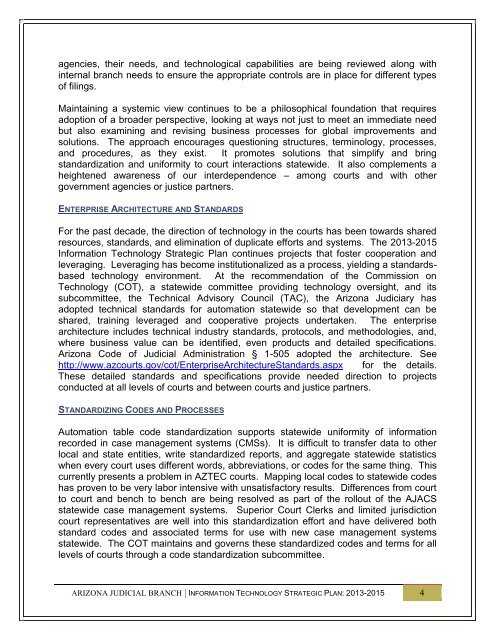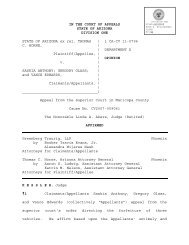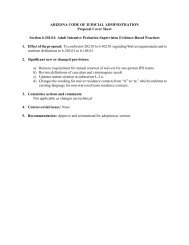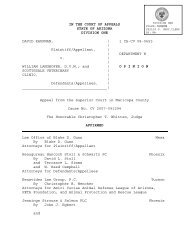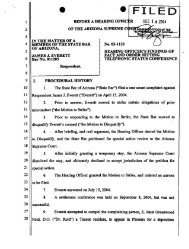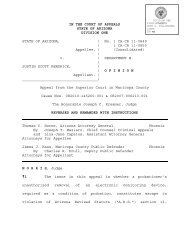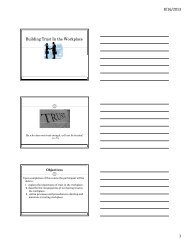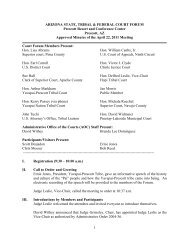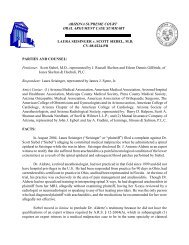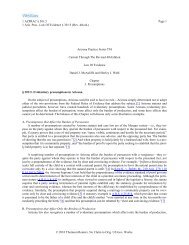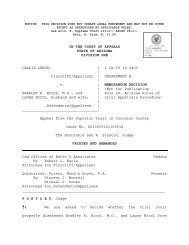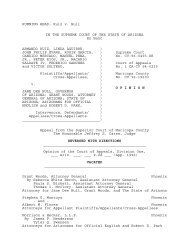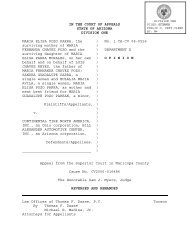Print Version - Arizona Judicial Department
Print Version - Arizona Judicial Department
Print Version - Arizona Judicial Department
Create successful ePaper yourself
Turn your PDF publications into a flip-book with our unique Google optimized e-Paper software.
agencies, their needs, and technological capabilities are being reviewed along with<br />
internal branch needs to ensure the appropriate controls are in place for different types<br />
of filings.<br />
Maintaining a systemic view continues to be a philosophical foundation that requires<br />
adoption of a broader perspective, looking at ways not just to meet an immediate need<br />
but also examining and revising business processes for global improvements and<br />
solutions. The approach encourages questioning structures, terminology, processes,<br />
and procedures, as they exist. It promotes solutions that simplify and bring<br />
standardization and uniformity to court interactions statewide. It also complements a<br />
heightened awareness of our interdependence – among courts and with other<br />
government agencies or justice partners.<br />
ENTERPRISE ARCHITECTURE AND STANDARDS<br />
For the past decade, the direction of technology in the courts has been towards shared<br />
resources, standards, and elimination of duplicate efforts and systems. The 2013-2015<br />
Information Technology Strategic Plan continues projects that foster cooperation and<br />
leveraging. Leveraging has become institutionalized as a process, yielding a standardsbased<br />
technology environment. At the recommendation of the Commission on<br />
Technology (COT), a statewide committee providing technology oversight, and its<br />
subcommittee, the Technical Advisory Council (TAC), the <strong>Arizona</strong> Judiciary has<br />
adopted technical standards for automation statewide so that development can be<br />
shared, training leveraged and cooperative projects undertaken. The enterprise<br />
architecture includes technical industry standards, protocols, and methodologies, and,<br />
where business value can be identified, even products and detailed specifications.<br />
<strong>Arizona</strong> Code of <strong>Judicial</strong> Administration § 1-505 adopted the architecture. See<br />
http://www.azcourts.gov/cot/EnterpriseArchitectureStandards.aspx for the details.<br />
These detailed standards and specifications provide needed direction to projects<br />
conducted at all levels of courts and between courts and justice partners.<br />
STANDARDIZING CODES AND PROCESSES<br />
Automation table code standardization supports statewide uniformity of information<br />
recorded in case management systems (CMSs). It is difficult to transfer data to other<br />
local and state entities, write standardized reports, and aggregate statewide statistics<br />
when every court uses different words, abbreviations, or codes for the same thing. This<br />
currently presents a problem in AZTEC courts. Mapping local codes to statewide codes<br />
has proven to be very labor intensive with unsatisfactory results. Differences from court<br />
to court and bench to bench are being resolved as part of the rollout of the AJACS<br />
statewide case management systems. Superior Court Clerks and limited jurisdiction<br />
court representatives are well into this standardization effort and have delivered both<br />
standard codes and associated terms for use with new case management systems<br />
statewide. The COT maintains and governs these standardized codes and terms for all<br />
levels of courts through a code standardization subcommittee.<br />
ARIZONA JUDICIAL BRANCH | INFORMATION TECHNOLOGY STRATEGIC PLAN: 2013-2015 4


